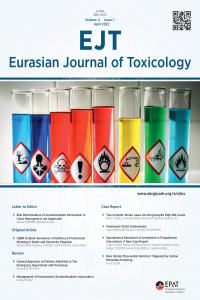Carbon Monoxide Poisoning: Comparison of Paediatric and Adult Patients
Carbon Monoxide Poisoning: Comparison of Paediatric and Adult Patients
Background: Carbon monoxide (CO) gas is a tasteless, odorless and colorless gas and causes many poisonings every year. In this study, paediatric and adult CO poisoning cases admitted to our emergency department were reviewed retrospectively.
Materials and Methods: Paediatric and adult patients who applied to the Emergency Department of Mardin Training and Research Hospital between 01 January 2021 and 31 December 2022 due to CO poisoning due to stove usage were included in the study. Patients were compared according to age, gender, month and time of admission to the emergency department, complaints at admission, laboratory test results and discharge status.
Results: 90 patients admitted to the emergency department due to CO poisoning caused by stoves between 2021-2022 were included in the study. While the rate of female patients in the paediatric age group was 53.3%, the rate of female patients in the adult group was 48.9% (p=0.673). When compared according to the complaints of admission to the hospital, the most common complaint in the paediatric age group was nausea-vomiting with 42.2%, while the most common complaint in the adult group was shortness of breath with 26.7%. In both groups, it was determined that the most frequent application was in January with 48.9%. While 15.6% of children were hospitalized, this rate was 4.4% for adults. (p=0.065). While the carboxyhemoglobin (COHb) value at the time of first admission was 18.36±6.60 in the paediatric group, it was 22.03±10.24 in the adult group (p:0.047). In the control blood gas values taken at discharge, COHb level was 2.76±1.83 in children and 5.10±3.02 in adults (p<0.001).
Conclusion: CO poisoning should always be considered in the differential diagnosis of patients who present to the emergency department with nonspecific symptoms during the winter months. It should not be forgotten that children are affected more and recovery is fast.
Keywords:
Carbon monoxide Emergency, Poisoning,
___
- Raub JA, Mathieu-Nolf M, Hampson NB, Thom SR. Carbon monoxide poisoning — a public health perspective. Toxicology. 2000;145(1):1-14. doi:10.1016/S0300-483X(99)00217-6.
- The Importance of Hyperbaric Oxygen Therapy In The Management of Carbon Monoxide Poisoning Is Neglected. doi:10.1007/s12012-019-09560-7
- Harper A, Croft-Baker J. Carbon monoxide poisoning: undetected by both patients and their doctors. Br Geriatr Soc. 2004;33(2):105-109. doi:10.1093/ageing/afh038
- Kao LW, Nañagas KA. Carbon monoxide poisoning. Emerg Med Clin North Am. 2004;22(4):985-1018. doi:10.1016/J.EMC.2004.05.003
- İncekaya Y, Feyizi H, Bayraktar S, et al. Cabon Monoxide Poisoning And Hyperbaric Oxygen Therapy. Med J Okmeydani Train Res Hosp. 2017;33(2):114-118. doi:10.5222/OTD.2017.1106
- Juurlink DN, Buckley N, Stanbrook MB, Isbister G, Bennett MH, McGuigan M. Hyperbaric oxygen for carbon monoxide poisoning. Juurlink DN, ed. Cochrane Database Syst Rev. 2005;(1). doi:10.1002/14651858.CD002041.PUB2
- İŞLER Y. Karbonmonoksit zehirlenmesi. Eurasian J Toxicol. 2022;11(3):54-60. doi:10.51262/ejtox.1101903
- Cho CH, Chiu NC, Ho CS, Peng CC. Carbon Monoxide Poisoning in Children. Pediatr Neonatol. 2008;49(4):121-125. doi:10.1016/S1875-9572(08)60026-1
- Guzman JA. Carbon monoxide poisoning. Crit Care Clin. 2012;28(4):537-548. doi:10.1016/J.CCC.2012.07.007
- Kurt F, Bektaş Ö, Kalkan G, Öncel MY, Yakut HI, Kocabaş CN. Does age affect presenting symptoms in children with carbon monoxide poisoning? Pediatr Emerg Care. 2013;29(8):916-921. doi:10.1097/PEC.0B013E31829EC22B
- Delice O, Daş M, Çelik K, Kavaklı Ş, Neşelioğlu H, Hatıl I. Evaluation of Plasma Total Thiol Levels in Patients with Carbon Monoxide Poisoning in the Emergency Department. Eurasian J Tox. 2023;5(1):1-4. Accessed July 6, 2023. https://dergipark.org.tr/ejtox
- Kumarihamy P, Kularatne SAM, Pathirage M, Gunaratne WMSN, Waduge R. A case of delayed neurological manifestation following carbon monoxide poisoning in Sri Lanka: epidemiology of exposure and literature review. BMC Pharmacol Toxicol. 2019;20(1):1-8. doi:10.1186/S40360-019-0295-9/FIGURES/4
- Altintop I, Akcin ME, Tatli M, Ilbasmis MS. Factors that influence the decision for hyperbaric oxygen therapy (HBOT) in cases of carbon monoxide poisoning: a retrospective study. Ann Burns Fire Disasters. 2018;31(3):168. Accessed May 6, 2023. /pmc/articles/PMC6367868/
- Klein JG, Alter SM, Paley RJ, et al. Carbon monoxide poisoning at a Florida Hospital following Hurricane Irma. Am J Emerg Med. 2019;37(9):1800-1801. doi:10.1016/J.AJEM.2019.03.009
- Metin S, Yildiz Ş, Çakmak T, Demirbaş Ş. Frequency of carbon monoxide poisoning in Turkey in 2010. TAF Prev Med Bull. 2011;10(5):587-592. doi:10.5455/PMB.20110417125648
- Akköse Ş, Türkmen N, Bulut M, Akgöz S, Işcimen R, Eren B. An analysis of carbon monoxide poisoning cases in Bursa, Turkey. East Mediterr Heal J. 2010;16(1):101-106. doi:10.26719/2010.16.1.101
- Makalesi A, Besli GE, Ergüven M, Karadoğan M, Yılmaz Ö. Çocuklarda Karbon Monoksit Zehirlenmesi Carbon Monoxide Poisoning in Children. doi:10.4170/JAEM.2009.19480
- Uysalol M, Uysalol EP, Saraçoǧlu GV, Kayaoǧlu S. Çocuk Acil Servise Karbon Monoksit Entoksikasyonu ile Başvuran Çocuk Hastaların Geriye Dönük Analizi. Balkan Med J. 2011;2011(3):237-243. doi:10.5174/TUTFD.2010.03766.1
- Keleş A, Demircan A, Kurtoǧlu G. Carbon monoxide poisoning: How many patients do we miss? Eur J Emerg Med. 2008;15(3):154-157. doi:10.1097/MEJ.0B013E3282EFD519
- Iqbal S, Clower JH, Boehmer TK, Yip FY, Garbe P. Carbon Monoxide-Related Hospitalizations in the U.S.: Evaluation of a Web-Based Query System for Public Health Surveillance. http://dx.doi.org/101177/003335491012500311. 2010;125(3):423-432. doi:10.1177/003335491012500311
- Weaver LK. Carbon Monoxide Poisoning. https://doi.org/101056/NEJMcp0808891. 2009;360(12):1217-1225. doi:10.1056/NEJMCP0808891
- Kandiş H, Katirci Y, Karapolat BS. Karbonmonoksit Zehirlenmesi. Düzce Üniversitesi Tıp Fakültesi Derg. 2009;11(3):54-60.
- Yayın Aralığı: Yılda 3 Sayı
- Başlangıç: 2019
- Yayıncı: Acil Tıp Uzmanları Derneği
Sayıdaki Diğer Makaleler
Two Patients of 113 and 77 Years Old of Atropa Belladonna Poisoning Case Report
Muhammet Mustafa YILMAZ, Hasan Hüseyin Alp ÇELİK
Epidemiological Survey of Theophylline Poisoning in a tertiary poison center
Zahra BAROONİAN, Maral RAMEZANİ, Peyman ERFAN TALAB EVİNİ, Shahin SHADNİA, Babak MOSTAFAZADEH, Mitra RAHİMİ
An Analysis of Dog and Cat Bite Cases Attending a Tertiary Care Hospital, Bursa
Serbülent KILIÇ, Cemal İlker CANDER, Ayşen ZEYBEK, Melih YÜKSEL
Systematic Review on Safety of Bisphenol A: from Invention to the Present
Hananeh KORDBACHEH, Bensu KARAHALİL
Carbon Monoxide Poisoning: Comparison of Paediatric and Adult Patients
